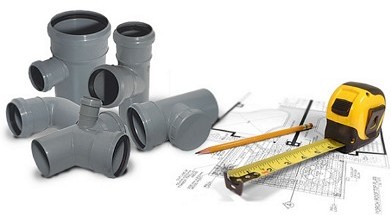Properly organized sewerage system should guarantee the basic criteria of the system's efficiency: complete tightness and trouble-free patency of pipes. The independent choice of sewer pipes should not be limited only by the choice of material of manufacture and diameter. The configuration and shape of the sewage system should be taken into account.
Content
How to arrange sewerage
For the selection of sewer pipes in the organization of sewage in an apartment or a private house, it is necessary to take into account the type of pipes and their diameter, and, of course, the configuration of the system.
The sewage system at the location and destination is divided into the following groups:
• internal, providing collection of drains and delivery to the sewage system of the external
• external, ensuring the delivery of drains to the point of discharge.
The organization of any type of sewerage involves the use of a certain type and type of pipes, as well as fittings for connection and sockets.
It is necessary to distinguish sewage pipes for internal or external sewerage. What parameters should be selected and what do experts advise?
Types of sewer pipes
Cast-iron pipes
More recently, 10-15 years ago, the most common sewer pipes were cast-iron pipes. Pipes cast-iron sewage regularly performed their functions for a long time, but had a poor resistance to constant dynamic loads.
It is known that the internal walls of cast-iron pipes have a rough surface. Therefore, there is a risk of sticking sewage and reducing the capacity of pipes. Probably, for this main reason, the cast-iron pipes gradually began to displace the sewage pipes from plastic. Plastic pipes have been successfully used for sewage systems. However, the replacement of the old cast-iron pipe with plastic is not always possible due to the need for additional modification of plastic pipes.
Advice from a specialist
The main drawback of pipes made of cast iron for their subsequent replacement can be called the complexity of installation, especially when fastening the pipes together. The maximum justified effect from the pipes can be achieved by using them to organize risers or laying the external sewage system.
In addition, it is necessary to take into account the composition of the soil in which the pipe is intended to be laid with external sewerage.
Which pipes are needed for outdoor sewerage
The specific location of the external sewage pipes should create resistance to dynamic impacts and withstand the load of soil and transport. According to building codes and rules: "pipes for external sewage lay below the depth of freezing of soils."
Pipes made of plastic
The peculiarity of the external sewage pipe is the increased chemical resistance to the negative impact of the aggressive environment and the simplicity of the design.
In modern sewerage systems of houses the most demanded are pipes from plastic - polyvinylchloride (PVC), polypropylene (PP) and polyethylene. Products of this type of pipe differ insignificant weight, strength and comfortable length. So, for example, a sewer pipe external from PVC has a standard diameter of 110 or 160 mm, the thickness of the plastic wall is 3.2 mm.
A sewage pipe with a diameter of 110 mm is manufactured by the manufacturer for diversion of external sewerage. An important factor for self-selection is the type of pipe connection, fittings and special chamfers (sockets), as well as the mandatory presence of a sealing ring. The presence of a sealing ring creates a sealed and secure joint.
When selecting pipes for external sewage, the optimal diameter should be selected in accordance with existing regulations and depending on the number of connections with sanitary devices.
Pipes made of PVC for outdoor sewage are divided by strength into the following classes:
• light - marking SN2
• middle markings SN4
• heavy - SN8.
For outdoor local sewerage, the most demanded are the plastic pipes corrugated sewer. Diameter of sewer corrugated pipes can reach 250-850 mm. The installation of such labor is carried out to a depth of up to 15 m. Thanks to the corrugated surface of PVC pipes, the necessary rigidity and strength are achieved.
Pipes made of PVC for outdoor use have a gray and orange color. The price of sewer plastic pipes is acceptable.
Advice from a specialist
Experts recall that the calculation of pipe diameters for connecting the elements of the sewage system is as follows:
• washbasin - ø 32-40 mm.
• baths - ø 50 mm.
• as a riser - ø 70-85 mm.
• for the outlet pipe (including the connection of the toilet) - ø 100 mm.
Which pipes are used for internal sewerage
Plastic pipes
The main purpose of plastic pipes of internal sewerage is the delivery of drains to drainage wells. Therefore, strict requirements to strength indicators are not imposed on the pipes of internal sewerage. Under any scheme of laying and installation of internal sewage pipes are not subject to intensive loading, as when laying the external sewerage system.
The main consumer qualities are:
• free internal surface providing drains
• strength and loyalty to aggressive influences
• Simple and affordable pipe replacement.
If you choose a preference is given to pipes made of plastic and metal-plastic composite. There is a limit on the pressure in PVC pipes - the maximum working pressure should not exceed 0.16 MPa.
PVC pipes for internal sewerage allow transporting sewage drains under the pressure of water and non-pressure type. For these purposes it is recommended to use PVC pipes, D50-500mm, as well as low noise systems of Wavin-AS pipes. Pipes for internal sewerage are usually gray.
Installation of pipes for sewage of any type involves the use of special devices - sewer fittings (fittings). According to the installation method, the fittings are of the following type:
• Threaded
• flanged
• Compression
• Self-locking.
More detailed information from a specialist is presented in this video.

































